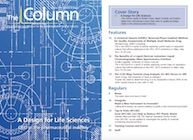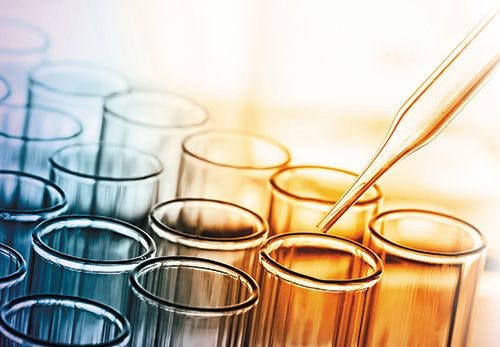The Benefits of a Liquid-Electron Ionization Liquid Chromatography–Mass Spectrometry Interface
This is the fourth in a series of articles exploring current topics in separation science that will be addressed at the HPLC 2019 conference in Milan, Italy, from 16–20 June.
Strawberry Blossom/stock.adobe.com

This is the fourth in a series of articles exploring current topics in separation science that will be addressed at the HPLC 2019 conference in Milan, Italy, from 16–20 June.
From its development in 2016, the liquid-electron ionization (LEI) liquid chromatography–mass spectrometry (LC–MS) (1) interface has demonstrated a high versatility, offering the identification advantages of library-searchable, electron ionization (EI) spectra from samples in a liquid phase.
The LEI concept is an innovative approach that efficiently manages the problematic conversion of a liquid phase into a gas phase (a mandatory requirement of EI) because LEI tolerates subâmicrolitreâperâminute flow rates only, and so the use of a nanoâLC (nLC) system is highly recommended. Higher flow rates would impact the ion source vacuum, which reduces sensitivity and filament lifetime. An excess of solvent vapours would also induce chemical ionization (CI) reactions with the formation of (M+H)+ ions that would affect the quality of the mass spectrum.
LEI represents a step forwards in LC–EI–MS performance (2), offering reliable and straightforward solutions for smallâmolecule applications. Identification of unknowns is of increasing importance in food safety, environmental, forensic, and many other applications where the complexity of the matrix is a troubling factor. The advantage of EI for tentative identification is unparalleled and provides an attractive alternative to highâresolution and high mass accuracy at a much lower cost.
A simple interfacing process and negligible solvent consumption makes LEI compatible with different types of liquid-phase introduction, including ultrahigh-pressure liquid chromatography (UHPLC), normal phase, and buffer-assisted separations, and is capable of detecting a large number of compounds, regardless of their polarities. The gas-phase ionization process and the negligible matrix effects allow real-time detection of target compounds without a sample preparation step (when possible).
In particular, the new approach offers strong matrix effects mitigation, full-scan, library-searchable EI spectra, and sensitive detection of nonpolar compounds, which are usually excluded by other LC–MS methods. None of the other available ionization techniques can analyze mixtures of substances in a range of polarities that spans from sugars to hydrocarbons in the same analysis.
Notably, the less-polar species would require a separate gas chromatography (GC)–MS analysis, with additional costs, complexity, and time. Despite the complex interfacing process, LEI is carefully designed not to introduce modifications in the chromatographic profile, and its presence is completely unnoticeable and does not induce peak broadening. The quality of the mass spectrum is not influenced by mobile phase residues and matches the one obtained with GC–MS instruments.
A specially designed vaporization chamber, called a vaporization microâchannel, physically separates the vaporization from the ionization step, allowing independent optimization of both processes without any particular compromise. The micro-channel is the core of the interface. Here the liquid sample is smoothly converted to the gas phase. The narrow and long shape of the chamber ensures a fast conversion and quick transfer of the sample vapours to the ion source, reducing the chances of thermal decomposition to a minimum. The transfer block that holds and guides the vaporization micro-channel to the ion source can be heated up to 400 °C, depending on the boiling point of the analytes. Nonvolatile sample residues remain as deposits inside this channel, reducing ion source contamination from complex samples. The fused-silica vaporization micro-channel is chemically inert and performs very well; it is easy and cheap to replace when needed for a hassle-free and inexpensive periodic maintenance of the system.
Our recent work has been oriented to explore the versatility of LEI in various directions: i) enhancing the performance towards high-molecular-weight compounds; ii) rapid detection applications without LC separation; and iii) real-time monitoring of reactions and processes.
Despite the reliance upon gas-phase ionization, the range of substances that can be effectively ionized by LEI is more extensive compared with GC–MS. The combination of fast heat transfer to the analyte and efficient vaporization drastically reduces the chance of thermal decomposition, allowing the detection of many GC- and LC-amenable analytes (3). The effect of different surface materials in the vaporization micro-channel is under investigation. Recent preliminary results demonstrate that glass-like ceramic is a promising alternative to stainless steel and fused silica as a vaporization surface. Poorly volatile compounds are readily available in the gas phase when ceramic is used. High cost and fragility still limit its use as a valid substitute for fused silica.
LEI has been successfully combined with condensed phase membrane introduction mass spectrometry (CP-MIMS) for onâline measurements in complex samples (4). Semipermeable membranes, such as polydimethylsiloxane (PDMS), are used to transfer neutral analytes by a condensed (liquid) acceptor phase to an MS system for real-time detection and quantitation. Ions and heterogeneous compounds cannot cross the membrane and do not reach the MS system. LEI paired with CP-MIMS allows the kinetics of organic reactions to be monitored on-line: neutral molecules can permeate the hydrophobic silicone membranes and are ionized under EI conditions. A chronogram allows the amounts of reagents and products over time to be monitored.
Food safety, forensic analyses, and quality control are analytical fields where MS plays a fundamental role, especially when focused on a targeted approach. Most protocols are based on LC–ESI–MS; however, the broad variability of these matrices needs a dedicated method for every sample, with an increase in complexity, time, and material consumption. LEI offers a technical solution that is not affected by matrix effects. This critical aspect may open the door to high-speed analytical protocols based on a “dilute-and-shoot” approach for semiquantitative, fast detection of specific analytes without chromatography. Extra-virgin olive (EVO) oil is one of the main components of the Mediterranean diet, thanks to its micronutrients content; phenols such as hydroxytyrosol and tyrosol are two of the most representative ones. We tested LEI–MS on several oil samples that were diluted and injected directly in the interface without any pretreatment. The two phenols of interest were detected and quantified. The complex olive oil matrix neither interferes with the quantitation of the analytes nor with the performance of the nLC–MS system, ensuring several consecutive analyses without loss of sensitivity or need of maintenance procedures.
References
- V. Termopoli et al., Anal. Chem.89, 2049–2056 (2017).
- V. Termopoli et al., J. Chromatogr. A Accepted for publication (2019). https://doi.org/10.1016/j.chroma.2019.01.034
- L. Magrini et al., JASMS27, 153–160 (2016).
- V. Termopoli et al., JASMS27, 301–308 (2016).
Achille Cappiello is a professor of analytical chemistry at the University of Urbino in Italy. He studied at the University of Rome La Sapienza in Italy, and after a two-year appointment as postdoctoral associate at the Massachusetts Institute of Technology in the USA, supervised by Professor Klaus Biemann, he began to engage in the field of LC–MS. He is the director of several projects dealing with LC–MS instrument development and design with some of the major manufacturers. He has published more than 150 scientific articles with an international circulation.
E-mail: achille.cappiello@uniurb.it

Advances in Non-Targeted Analysis for PFAS in Environmental Matrices
March 27th 2025David Megson from Manchester Metropolitan University in Manchester, UK, spoke to LCGC International about the latest developments in non-targeted analysis (NTA) of per- and polyfluoroalkyl substances (PFAS) in environmental matrices based on a recent systematic review paper he has collaboratively published (1).
Study Explores Thin-Film Extraction of Biogenic Amines via HPLC-MS/MS
March 27th 2025Scientists from Tabriz University and the University of Tabriz explored cellulose acetate-UiO-66-COOH as an affordable coating sorbent for thin film extraction of biogenic amines from cheese and alcohol-free beverages using HPLC-MS/MS.












